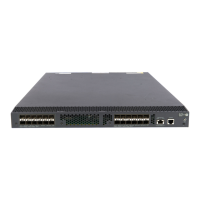128
Ste
Command
Remarks
5. Specify the destination port of
UDP packets.
destination port port-number
By default, no destination port
number is specified.
The destination port must be the
same as that of the listening service
on the NQA server.
6. (Optional.) Specify the source
port number of UDP packets.
source port port-number
By default, no source port number
is specified.
7. (Optional.) Specify the
payload size in each UDP
packet.
data-size size The default setting is 100 bytes.
8. (Optional.) Specify the string
to be filled in the payload of
each UDP packet.
data-fill string
The default setting is the
hexadecimal number
00010203040506070809.
9. Specify the number of UDP
packets sent in one UDP jitter
operation.
probe packet-number
packet-number
The default setting is 10.
10. Configure the interval for
sending UDP packets.
probe packet-interval
packet-interval
The default setting is 20
milliseconds.
11. Specify how long the NQA
client waits for a response
from the server before it
regards the response times
out.
probe packet-timeout
packet-timeout
The default setting is 3000
milliseconds.
12. (Optional.) Specify the source
IP address for UDP packets.
source ip ip-address
By default, no source IP address is
specified.
The source IP address must be the
IP address of a local interface, and
the interface must be up.
Otherwise, no UDP packets can be
sent out.
NOTE:
Use the display nqa result command or the display nqa statistics command to verify the UDP jitter
operation. The display nqa history command does not display the UDP jitter operation results or statistics.
Configuring the SNMP operation
The SNMP operation measures the time for the NQA client to get a response packet from an SNMP
agent.
To configure the SNMP operation:
Ste
Command
Remarks
1. Enter system view.
system-view N/A
2. Create an NQA operation
and enter NQA operation
view.
nqa entry admin-name
operation-tag
By default, no NQA operation is
created.

